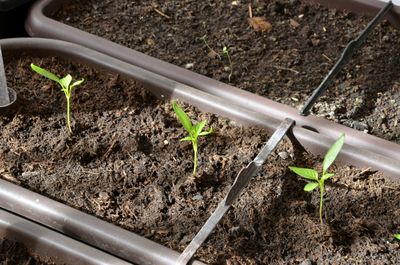When to Start Hot Pepper Seeds
It’s good to get started about six to 10 weeks before the last average frost date in your area. In most climates, January is a great time for germinating hot pepper seeds, but you may want to start as early as November or as late as February. Keep in mind that super-hot peppers, like habanero or Scotch bonnet, take longer to germinate than milder peppers, and they also require more warmth.
Growing Hot Peppers from Seeds
Soak the hot pepper seeds in warm water overnight. Fill a tray of celled containers with seed-starting mix. Water well, then set the trays aside to drain until the mix is moist but not soggy. Sprinkle seeds over the surface of the moist seed starting mix. Cover the tray with clear plastic or slide it into a white plastic garbage bag. Germinating hot pepper seeds requires warmth. The top of a refrigerator or other warm appliance works well, but you may want to invest in a heat mat. Temperatures of 70 to 85 F. (21-19 C.) are ideal. Check the trays frequently. The plastic will keep the environment warm and moist, but be sure to water or mist lightly if the seed starting mix feels dry. Watch for the seeds to germinate, which may occur as soon as a week, or may take as long as six weeks, depending on temperatures and variety. Remove the plastic as soon as the seeds germinate. Place the trays under fluorescent bulbs or grow lights. The seedlings need at least six hours of sunlight per day.
Tips on Hot Pepper Seedling Care
Use scissors to cut the weakest seedlings in each cell, leaving the strongest, sturdiest seedling. Place a fan near the seedlings, as a steady breeze will promote stronger stems. You can also open a window if the air isn’t too cold. Transplant the seedlings to 3- to 4-inch pots (7.5-10 cm.) filled with regular potting mix when they’re large enough to handle. Continue growing the hot pepper plants indoors until they’re large enough to transplant, hardening them off beforehand. Be sure the days and nights are warm with absolutely no risk of frost.
